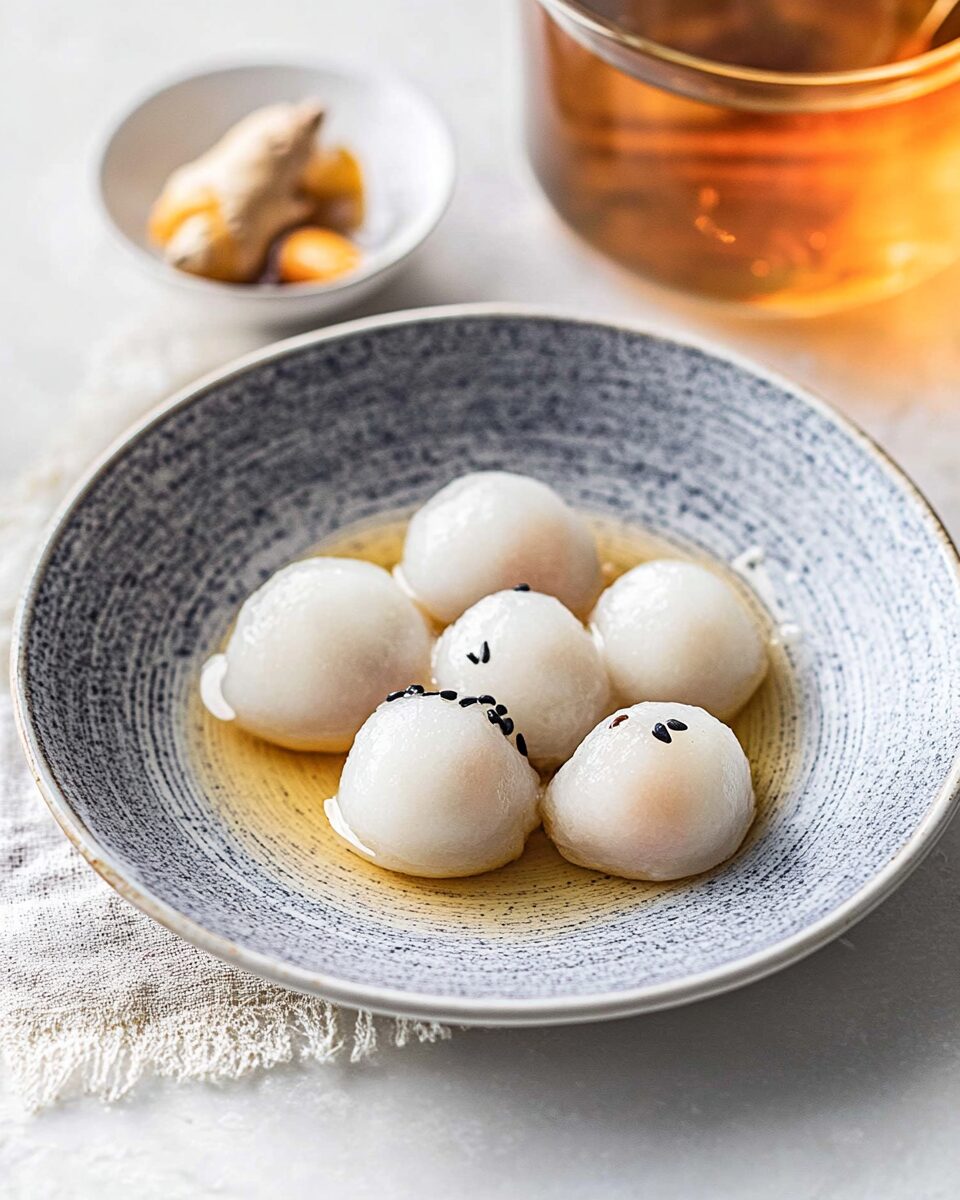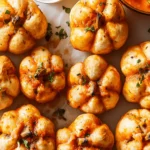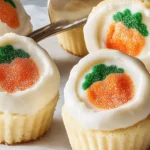A traditional Chinese dessert, Sweet Tang Yuan Dumplings are soft, chewy glutinous rice balls filled with sweet sesame paste, served in a lightly sweetened ginger syrup. These dumplings are especially popular during festive celebrations and symbolize unity and togetherness.
FULL RECIPE
Ingredients
- 1 1/2 cups glutinous rice flour
- 1/2 cup warm water (plus more as needed)
- 1/3 cup black sesame seeds
- 3 tablespoons sugar (for filling)
- 3 tablespoons unsalted butter (softened)
- 4 cups water (for boiling)
- 3 slices fresh ginger
- 1/4 cup brown sugar (for syrup)
Directions
- Toast black sesame seeds in a dry pan over medium heat until fragrant, about 2–3 minutes.
- Grind toasted sesame seeds into a fine powder using a food processor or mortar and pestle.
- Mix sesame powder with sugar and softened butter until a thick paste forms. Chill in the refrigerator for 30 minutes.
- In a bowl, gradually mix warm water into glutinous rice flour to form a smooth, pliable dough.
- Divide dough into small balls (about 1 inch wide).
- Flatten each ball, place a small amount of sesame filling in the center, then carefully seal and roll back into a ball.
- In a saucepan, bring 4 cups of water to a boil. Add ginger slices and brown sugar to create the syrup. Simmer for 5–10 minutes.
- In another pot, bring water to a boil. Drop dumplings in and cook until they float, then simmer for an additional 2–3 minutes.
- Transfer cooked dumplings into the ginger syrup and serve warm.
Nutritional Information
- Calories: 120 per dumpling
- Carbohydrates: 20g
- Protein: 2g
- Fat: 4g
- Fiber: 1g
- Sugar: 6g
Cultural Significance of Tang Yuan
Tang Yuan is deeply embedded in Chinese culture, especially during festivals like the Lantern Festival and Winter Solstice. These glutinous rice balls symbolize reunion, harmony, and completeness. The round shape of Tang Yuan represents family togetherness, making it a staple during important gatherings. Their presence on the table is a gesture of love and connection between family members.
Origins of Tang Yuan
Tang Yuan dates back to the Song Dynasty, where it was first called “Yuanxiao.” Over time, regional variations led to the use of different names and slightly altered preparation methods. Southern China predominantly refers to them as Tang Yuan, while Northern China maintains the name Yuanxiao. Despite these distinctions, the essence of the dish remains rooted in tradition.
Texture and Flavor Profile
One of the defining features of Tang Yuan is its soft, chewy texture, which comes from glutinous rice flour. The filling, often made from black sesame, peanut, or red bean paste, adds a contrasting richness. The balance between the subtle sweetness of the dough and the bold flavors of the filling creates a harmonious bite that’s both comforting and satisfying.
Common Fillings and Variations
Black sesame is the most traditional filling, prized for its nutty and slightly bitter-sweet taste. However, other popular options include sweet red bean paste, crushed peanuts with sugar, and even chocolate or fruit-based fillings in modern adaptations. Savory Tang Yuan filled with minced meat or mushrooms also exist in some regional cuisines.
Serving Styles Across Regions
Tang Yuan can be served in different ways depending on the region. In Southern China, they are commonly served in a light ginger-infused syrup, adding warmth and a subtle spiciness. In contrast, Northern versions might be dry-coated in crushed nuts or sesame seeds. These regional differences reflect diverse tastes and culinary customs.
Symbolism in Festive Occasions
Beyond its delicious flavor, Tang Yuan carries profound symbolic meanings. During the Lantern Festival, it marks the end of Chinese New Year celebrations and is eaten to promote unity. On the Winter Solstice, it represents the arrival of longer days and the hope of renewal. The act of sharing Tang Yuan is often seen as an expression of goodwill and prosperity.
Nutritional Aspects and Health Considerations
Tang Yuan is rich in carbohydrates due to its glutinous rice content, offering a quick source of energy. The sesame or nut fillings add healthy fats and some protein. However, the sugar content can be high, so it’s best enjoyed in moderation. Health-conscious adaptations may use less sugar, whole grain rice flour, or even steamed versions to reduce calorie intake.
Modern Adaptations and Innovations
Contemporary chefs have taken creative liberties with Tang Yuan, introducing flavors like matcha, taro, and even salted egg yolk. Some versions feature colorful dough made with natural plant-based dyes such as butterfly pea flower or beetroot. These innovations keep the dish relevant for younger generations while honoring its cultural roots.
Making Tang Yuan as a Family Activity
The process of making Tang Yuan is simple enough to involve all family members, including children. Rolling the dough and filling the dumplings becomes a bonding activity. This hands-on preparation fosters a sense of participation in cultural heritage, especially for those living outside of Asia who wish to maintain traditional practices.
Tang Yuan in Other Asian Cuisines
While Tang Yuan is distinctly Chinese, similar glutinous rice ball desserts exist in other Asian cultures. In Japan, a comparable treat is mochi, though it’s usually not filled. In Vietnam, bánh trôi nước is a similar dessert with a mung bean filling. These parallels highlight the shared culinary themes across the region.
Preservation and Storage Tips
Tang Yuan can be made in large batches and frozen for future use. To freeze, arrange uncooked dumplings on a tray until firm, then transfer them to a sealed bag. They can be cooked directly from frozen without thawing. Cooked Tang Yuan should be consumed within a day or two to maintain their ideal texture.
Tang Yuan in Contemporary Celebrations
Today, Tang Yuan is not limited to traditional festivals. It is also served at birthdays, weddings, and other family milestones. Its adaptability and symbolic meaning have made it a favorite comfort food. Some even enjoy it as a casual dessert or snack throughout the year.
Popular Flavor Pairings
Tang Yuan pairs well with ingredients that balance its sweetness, such as ginger syrup, coconut milk, or osmanthus flowers. The warming nature of ginger complements the chewy texture of the rice balls, while floral accents elevate the sensory experience. Experimenting with pairings can personalize the dish for different palates.
Differences Between Tang Yuan and Yuanxiao
Although often used interchangeably, Tang Yuan and Yuanxiao differ in preparation. Tang Yuan dough is kneaded and wrapped around filling, while Yuanxiao is made by repeatedly rolling balls of filling in dry glutinous rice flour. This results in a more crumbly texture. The regional distinction reflects unique culinary traditions in North and South China.
Importance of Shape and Appearance
The round shape of Tang Yuan is not only aesthetically pleasing but also deeply symbolic. Roundness in Chinese culture signifies completeness, continuity, and good fortune. The smooth surface of each dumpling is considered a sign of skilled craftsmanship and is often emphasized in homemade versions.
Gluten-Free and Vegan Variations
Because the base of Tang Yuan is made from glutinous rice flour, it is naturally gluten-free. This makes it accessible for those with gluten sensitivities. Vegan versions are easy to achieve by using plant-based fillings and avoiding any dairy-based ingredients in the paste. Coconut oil can replace butter for a completely plant-based treat.
Culinary Tools and Equipment Needed
Making Tang Yuan requires minimal equipment: just a mixing bowl, saucepan, and your hands. For a finer sesame filling, a spice grinder or food processor can help achieve a smooth consistency. No special molds or tools are required, making it an approachable recipe for most home kitchens.
Challenges and Solutions in Preparation
One common challenge is the dough cracking or drying out during shaping. This can be resolved by covering unused dough with a damp cloth and working quickly. If the dough is too dry, a few drops of water can restore pliability. Ensuring the filling is firm from chilling also helps prevent leaks during cooking.
Restaurant vs. Homemade Tang Yuan
Store-bought Tang Yuan offers convenience and consistency, but homemade versions allow for customization and freshness. Restaurant-style Tang Yuan may feature more elaborate presentations, but nothing matches the nostalgic value of family-made dumplings. Homemade versions often taste more authentic and meaningful.
Conclusion
Tang Yuan is much more than just a dessert—it’s a cherished cultural icon that brings people together. Its soft, comforting texture and warm, sweet filling evoke feelings of home, heritage, and celebration. Whether enjoyed during a traditional holiday or as an everyday treat, Tang Yuan continues to connect generations through taste and tradition. With countless variations and modern twists, this beloved dish endures as a symbol of unity, joy, and the enduring power of food to bridge time and distance.






